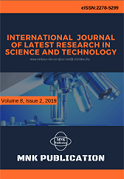DOI:10.29111/ijlrst ISRA Impact Factor:3.35, Peer-reviewed, Open-access Journal
Research Paper Open Access
International Journal of Latest Research in Science and Technology Vol.3 Issue 2, pp 73-79,Year 2014
Correspondence should be addressed to :
Received : 22 April 2014; Accepted : 27 April 2014 ; Published : 30 April 2014

| Download | 125 |
|---|---|
| View | 180 |
| Article No. | 10280 |
The Sn-doped ZnO thin films were deposited on glass and ITO substrates by sol gel spin coating technique. The structural, optical and electrical properties of Sn-doped ZnO thin films were studied and discussed. The Sn-doped ZnO thin film particle sizes were decreased whenever the doping concentration increased. Furthermore, high average transmittance of 96% in visible region and resistivity 7.7 x 102 Ω.cm were obtained with 2 at% Sn-doped ZnO as well as aligned ZnO nanorod arrays with large surface area were grown on 2 at.% Sn-doped ZnO film by using sol gel immersion ultrasonic assisted. Besides that, the optical properties of grown aligned ZnO nanorod arrays shows high transmittance at visible region that favorable for dye-sensitized solar cell. At 2 at.% Sn-doped film ZnO nanorod had higher IPEC due to high light scattering and enhance the photogenaration from absorbed dye. Therefore, dye sensitized solar cell at 2.0 at.% Sn-doped ZnO thin film with ZnO Nanorod arrays have an improved of current density, open circuit voltage, fill factor, and conversion efficiency.
Copyright © 2014 I. Saurdi et al. This is an open access article distributed under the Creative Commons Attribution 4.0 International (CC BY 4.0) license which permits unrestricted use, distribution, and reproduction in any medium, provided the original work is properly cited.
I. Saurdi,M. Rusop , " Solution-based Growth Of Zno Nanorod Arrays With Szo Films And Their Application In Dye-sensitized Solar Cell ", International Journal of Latest Research in Science and Technology . Vol. 3, Issue 2, pp 73-79 , 2014

MNK Publication was founded in 2012 to upholder revolutionary ideas that would advance the research and practice of business and management. Today, we comply with to advance fresh thinking in latest scientific fields where we think we can make a real difference and growth now also including medical and social care, education,management and engineering.

We offers several opportunities for partnership and tie-up with individual, corporate and organizational level. We are working on the open access platform. Editors, authors, readers, librarians and conference organizer can work together. We are giving open opportunities to all. Our team is always willing to work and collaborate to promote open access publication.

Our Journals provide one of the strongest International open access platform for research communities. Our conference proceeding services provide conference organizers a privileged platform for publishing extended conference papers as journal publications. It is deliberated to disseminate scientific research and to establish long term International collaborations and partnerships with academic communities and conference organizers.